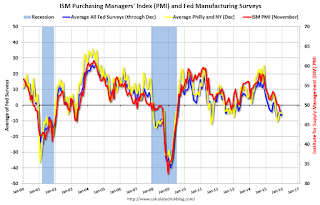by Calculated Risk on 12/28/2015 10:30:00 AM
Monday, December 28, 2015
Dallas Fed: "Texas Manufacturing Activity Rises Again, but Outlook Worsens" in December
From the Dallas Fed: Texas Manufacturing Activity Rises Again, but Outlook Worsens
Texas factory activity increased for a third month in a row in December, according to business executives responding to the Texas Manufacturing Outlook Survey. The production index, a key measure of state manufacturing conditions, rose from 5.2 to 13.4, indicating stronger growth in output.Output increased, but the general business activity index declined sharply. This was the last of the regional Fed surveys for December. Four out of five of the regional surveys indicated contraction in December, especially in oil producing areas.
...
Perceptions of broader business conditions weakened markedly in December. The general business activity index has been negative throughout 2015 and plunged to -20.1 this month. After pushing just above zero last month, the company outlook index fell 10 points in December to -9.7, its lowest level since August.
Labor market indicators reflected a notable rise in December. The employment index inched up further to 12.8; 26 percent of firms noted net hiring, while 14 percent noted net layoffs. The hours worked index suggested longer workweeks and rose to 15.2, its highest level since May 2010.
emphasis added
Here is a graph comparing the regional Fed surveys and the ISM manufacturing index:
 Click on graph for larger image.
Click on graph for larger image.The New York and Philly Fed surveys are averaged together (yellow, through December), and five Fed surveys are averaged (blue, through December) including New York, Philly, Richmond, Dallas and Kansas City. The Institute for Supply Management (ISM) PMI (red) is through November (right axis).
It seems likely the ISM index will be weak in December, and will probably show contraction again; a reading below 50. (although these regional surveys overemphasize oil producing areas).


